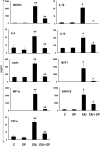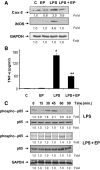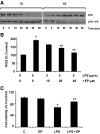Preventive effects of ethyl pyruvate on endotoxin-induced uveitis in rats
- PMID: 21551413
- PMCID: PMC3176034
- DOI: 10.1167/iovs.10-7047
Preventive effects of ethyl pyruvate on endotoxin-induced uveitis in rats
Abstract
Purpose: Recent studies indicate that ethyl pyruvate (EP) exerts anti-inflammatory properties; however, the effect of EP on ocular inflammation is not known. The efficacy of EP in endotoxin-induced uveitis (EIU) in rats was investigated.
Methods: EIU in Lewis rats was developed by the subcutaneous injection of lipopolysaccharide (LPS; 150 μg). EP (30 mg/kg body weight) or its carrier was injected intraperitoneally 1 hour before or 2 hours after lipopolysaccharide injection. Animals were killed after 3 and 24 hours followed by enucleation of eyes and collection of the aqueous humor (AqH). The number of infiltrating cells and levels of proteins in the AqH were determined. The rat cytokine/chemokine multiplex method was used to determine level of cytokines and chemokines in the AqH. TNF-α and phospho-nuclear factor kappa B (NF-κB) expression in ocular tissues were determined immunohistochemically. Human primary nonpigmented ciliary epithelial cells (HNPECs) were used to determine the in vitro efficacy of EP on lipopolysaccharide-induced inflammatory response.
Results: Compared to controls, AqH from the EIU rat eyes had a significantly higher number of infiltrating cells, total protein, and inflammatory cytokines/chemokines, and the treatment of EP prevented EIU-induced increases. In addition, EP also prevented the expression of TNF-α and activation of NF-κB in the ciliary bodies and retina of the eye. Moreover, in HNPECs, EP inhibited lipopolysaccharide-induced activation of NF-κB and expression of Cox-2, inducible nitric oxide synthase, and TNF-α.
Conclusions: Our results indicate that EP prevents ocular inflammation in EIU, suggesting that the supplementation of EP could be a novel approach for the treatment of ocular inflammation, specifically uveitis.
Figures







References
-
- Holleman MAF. Notice sur l'action de l'eau oxygénée sur les acétoniques et sur le dicétones. Recl Trav Chim Pays-bas Belg. 1904;23:169–171
-
- Ervens B, Gligorovski S, Herrmann H. Temperature dependent rate constants for hydroxyl radical reactions with organic compounds in aqueous solutions. Phys Chem Chem Phys. 2003;5:1811–1824
-
- Varma SD, Hegde KR. Lens thiol depletion by peroxynitrite. Protective effect of pyruvate. Mol Cell Biochem. 2007;298:199–204 - PubMed
-
- Kao KK, Fink MP. The biochemical basis for the anti-inflammatory and cytoprotective actions of ethyl pyruvate and related compounds. Biochem Pharmacol. 2010;80:151–159 - PubMed
-
- Yang R, Gallo DJ, Baust JJ, et al. Ethyl pyruvate modulates inflammatory gene expression in mice subjected to hemorrhagic shock. Am J Physiol Gastrointest Liver Physiol. 2002;283:G212–G222 - PubMed
Publication types
MeSH terms
Substances
Grants and funding
LinkOut - more resources
Full Text Sources
Other Literature Sources
Research Materials

